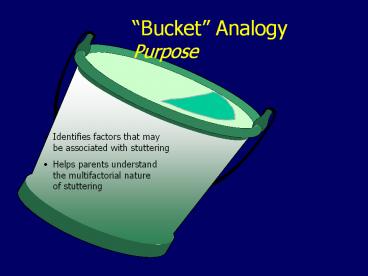Bucket Analogy Purpose - PowerPoint PPT Presentation
Title:
Bucket Analogy Purpose
Description:
The more time a child spends speaking fluently, the less likely the ... Limited free time or quiet time. Others in the home talk fast. or interrupt frequently ... – PowerPoint PPT presentation
Number of Views:140
Avg rating:3.0/5.0
Title: Bucket Analogy Purpose
1
Bucket AnalogyPurpose
- Identifies factors that maybe associated with
stuttering - Helps parents understandthe multifactorial
natureof stuttering
2
Bucket AnalogyFactors
- Factors interact
- Cannot distinguish influence of individual
factors once they are in the bucket
3
Bucket AnalogyGuidelines
- Begin at the bottomand work up
- Identify factors we havemore control over and
factors we have lesscontrol over
4
Communication Wellness Analogy
- Purpose
- Describes structure flow of treatment
- Guidelines
- Begin at the bottom and work up
- Explain that not all all steps may be necessary
Direct Child Intervention
ParentObservation
StrategyPractice
Treatment Flow
Parent Sessions
5
Communication Wellness
- Normal fluency in conversational speech
- Easy Talking
- Conversational Level
- Direct Model to Question Model
- Sentences Phrases Words
- Model Practice
- Delayed Response
- Reduplication/Rephrasing
- Decreased Questioning
- Easy Talking
- Modify interpersonal stressors
- Chart home disfluencies
- Modify communicative stressors
- Discuss types of disfluencies
- Administer Stressor Inventory
Direct Child Intervention
ParentObservation
StrategyPractice
Treatment Flow
Parent Sessions
6
Discussing Types of Disfluencies
- Helps parents learn to distinguish between
different disfluency types - Helps parents understand how to view progress
during treatment - Reduces parental misconceptions
- stuttering is just repetition
- prolongations are better than repetitions
7
Continuum ofSpeech Disfluencies(adapted from
Gregory, Campbell, Hill, and others)
- More Typical
- Interjections
- Revisions
- Phrase repetitions
- Multisyllabic whole- word repetitions
- Crossover Behaviors
- Monosyllabic whole- word repetitions
- Part-word repetitions
- No tension/struggle
- 1 2 iterations
- Less Typical
- Part-word repetitions
- 3 or more iterations
- Prolongations
- Blocks
8
Examining Stressors
- Compare stressor inventories completed by both
parents - Parents may view situations differently
- Focus on interpersonal stressors first
- Establish need for additional counseling
- Discuss ways to modify stressors
- Parents take lead in finding solutions
9
Home Charting
- Increase parents awareness of
- Situational factors that affect fluency
- Their reactions to their childs stuttering
- Helps parents focus their energy on helping the
child rather than worrying - Gives opportunity to assess parents commitment
to treatment early in the therapeutic process
10
Home Charting
- Guidelines
- No Aha! expected
- Provide examples of successful charting(see
handout) - Parents should bring completed chartto next
treatment session
11
Provide Supporting Literature
- Reassures parents that others have had similar
concerns and questions - Provides concrete examples of ways parents can
help their children - Additional opportunity to assess parents
commitment to treatment
12
Examples of Supporting Literature
- Stuttering Foundation of America (SFA)
- Stuttering and Your Child Questions Answers
- If Your Child Stutters A Guide for Parents
- National Stuttering Association (NSA)
- Stuttering Center Handouts
- Internet Resources
- Stuttering Home Page
13
Session 2
- Overview of FluencyEnhancing Strategies
14
Goals for Session 2
- Additional opportunity for counseling to to
address parents concerns - Further explore interpersonal stressors (when
applicable) - Begin the process of modifying communicative
stressors - Introduce next phase of treatment parent/child
modeling
15
Guidelines for Session 2
- First, Review Info from Session 1
- Review results from home charting
- Answer questions about booklets and supporting
literature - Address parents concerns about treatment and
childs fluency - Continue discussion of interpersonal stressors
and modifications
16
Fluency Enhancing Strategies
- Reducing parents speaking rates
- Reducing time pressures
- Reducing demand for talking
- Modifying questioning
- Providing supportivecommunicative environment
17
Preparing for Parent-Child Modeling Sessions
(Sessions 3-6)
- Provide overview of session flow
- Explain the need to videotape sessions (have
parents bring tape to next session) - Briefly introduce Easy Talking asthe first
strategy to be addressed - Familiarize parents with wireless microphone
system
18
Wireless Microphone System
UseEasy Talking
WirelessXmitter (TelexTW-6)
(Easy Talking)
WirelessReceiver (TelexAAR-1)
19
Session 3
- Easy Talking
20
Goals for Session 3
- Train parents to use Easy Talking
- Slower than parents habitual rate, but not too
slow, choppy, or robot-like - Introduce phrased speech as a preferred way to
reduce speaking rate - Explain that the goal for the parents speaking
rate is somewhere in between the rate they will
practice in treatment and the rate they used
before treatment
21
Guidelines for Session 3
- Set up video equipment and wireless microphone
system before session - Review Easy Talking handout
- Introduce phrasing as a preferred way to reduce
speaking rate - Explain that the goal for the parents speaking
rate is somewhere in between the rate they will
practice in treatment and the rate they used
before treatment
22
Model and Practice Easy Talking
- Clinician models Easy Talking withthe child
while parents observe - One parent interacts with childwhile receiving
on-line feedback - Second parent interacts with childwhile
receiving on-line feedback - Discuss observations and importanceof reviewing
videotape at home































